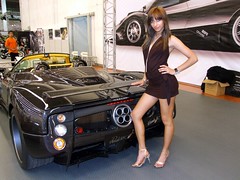Audi is showing an uncompromising purist compact sports car with all-electric drive at the 2010 NAIAS. The Detroit Audi e-tron Concept is 3.93 meter (154.72 in) long and 1.78 meter (70.08 in) wide but just 1.22 meter (48.03 in) tall two-seater; just a few months after the debut of the Audi e-tron Concept at the 2009 Frankfurt Motor Show, this is now the second electric concept vehicle from the brand with the four rings. Coupled with the Detroit Audi e-tron Concept's low gross weight of around only 1,350 kilograms (2976.24 lb), high-torque power units driving the rear wheels guarantee commensurate road performance.

2010 Audi e-tron Concept Car
Two electric motors in sync with a total capacity of 150 kW (204 hp) Audi give Detroit Audi e-tron, use the concept of the performance of a real sports car. Concept car can accelerate from 0 to 100 km / h (0 to 62.14 mph) in 5.9 seconds, if necessary, and goes from 60 to 120 km / h (37.28 to 74.56 mph) in 5.1 seconds.

2010 Audi e-tron Concept Car
And a top speed limited to 200 kmh (124.27 mph), the amount of energy needed to increase the electric motors are disproportionately in speed. Fraction in the combined cycle NEP nearly 250 kilometers (155.34 miles). The energy storage unit in charge of household current (230 volts and 16 amps) through the cable and components.

2010 Audi e-tron Concept Car
Socket behind a curtain in the back of the car. Download time when the battery is approximately 11 hours, but the heavy current (400 volts and 32 amps) of these cuts to about two hours only.
The Detroit Audi e-tron Concept in its further developed version goes one decisive step further into the future; an electro-mechanical brake system means the potential of electric motors for energy recovery can now be exploited. A hydraulic fixed-caliper brake is mounted on the front axle, with two novel, electrically actuated floating-caliper brakes mounted on the rear axle. These floating calipers are actuated not by any mechanical or hydraulic transfer elements, but rather by wire ("brake by wire"). In addition, this eliminates frictional losses due to residual slip when the brakes are not being applied.

2010 Audi e-tron Concept Car
The drive system's power is transferred to the road by the rear wheels, reflecting the Audi e-tron's weight distribution of 40:60.
Both the individual motors, which are installed behind the wheels close to the vehicle's center line as wheel drives, also enable the Detroit Audi e-tron Concept's lateral dynamics to be intelligently controlled. This also boosts traction. Similar to what the sport differential does in conventional Audi vehicles, torque vectoring - the targeted acceleration of individual wheels - makes the newly developed electric drive of the Detroit Audi e-tron Concept even more dynamic while simultaneously enhancing driving safety.
Understeer and oversteer can be corrected by not only targeted activation of the brakes, but also by precise increases in power lasting just a few milliseconds. The concept car remains extremely neutral even under great lateral acceleration and hustles through corners as if on the proverbial rails.


2010 Audi e-tron Concept Car
The chassis has triangular double wishbones made of forged aluminum components at the front and rear axles - a geometry that has proven in motor sports to be the optimal prerequisite for high agility, uncompromising precision and precisely defined self-steering behavior. A taut setup was chosen for the springs and shock absorbers, but it is still very comfortable.
Audi e-tron concept car moves on wheels 19-inch 35 - spoke design. 235/35 front tires and 255/35 rear tires provide excellent grip. Other special feature of tires: Audi designers created a special file for the Detroit Audi e-tron, use the concept.














